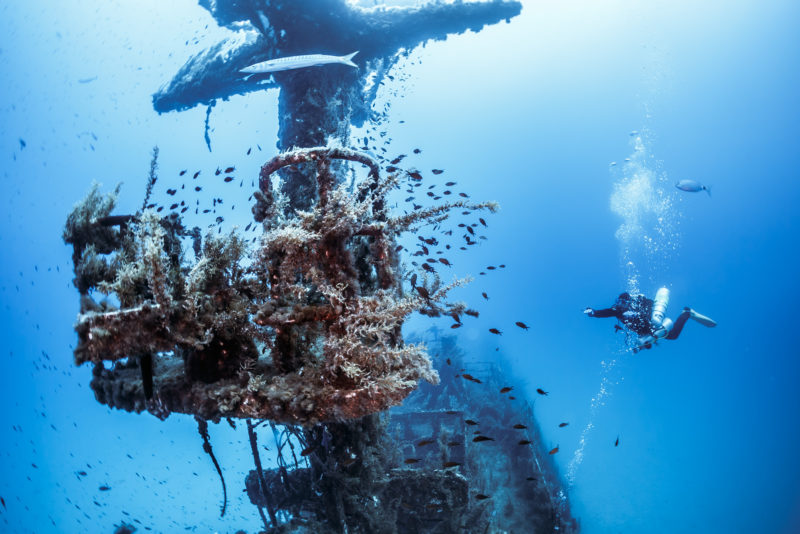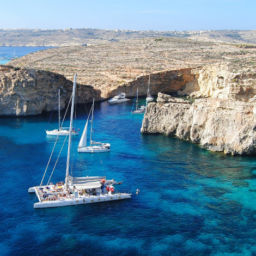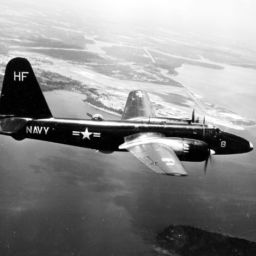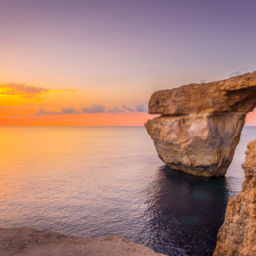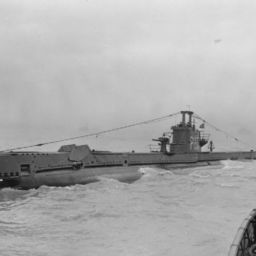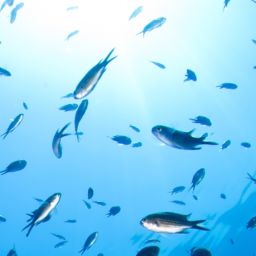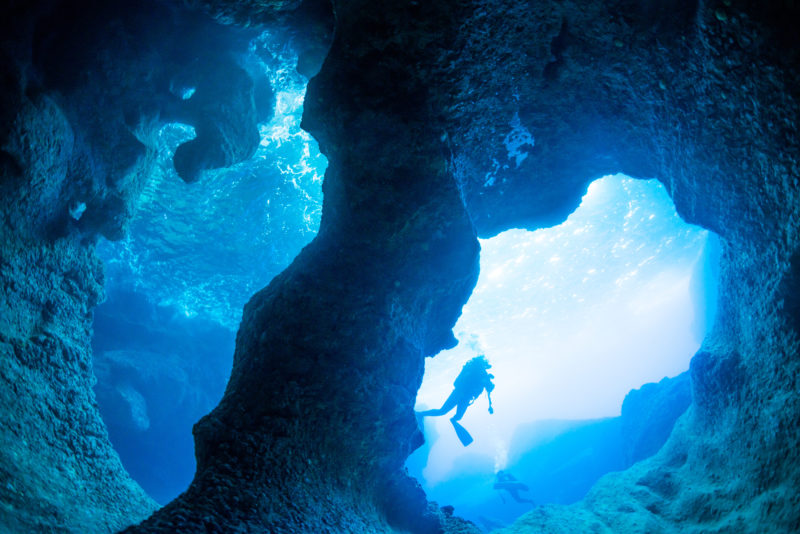 Sitting in the middle of the Mediterranean Sea, the Maltese Islands offer fantastic diving that is easily accessible from all over Europe. It’s especially popular with U.K. divers, as it’s only a three-hour flight away. Around the three islands — Malta, Gozo, and Comino — the water ranges from 60 to 77 F (16 to 25 C), and offers some of the best year-round visibility anywhere in the world. Divers would consider 98 feet (30 m) an average day. We can sum up the diving in four words: wrecks, reefs, cliffs, and more wrecks (okay, five words). It’s a wreck-diver’s paradise, offering a window into history for both recreational and technical divers. There are so many great dive sites here, it’s especially difficult to pick out the best, but nonetheless we’ll try. Here are the sites we chose to represent the best scuba diving in Malta.
Sitting in the middle of the Mediterranean Sea, the Maltese Islands offer fantastic diving that is easily accessible from all over Europe. It’s especially popular with U.K. divers, as it’s only a three-hour flight away. Around the three islands — Malta, Gozo, and Comino — the water ranges from 60 to 77 F (16 to 25 C), and offers some of the best year-round visibility anywhere in the world. Divers would consider 98 feet (30 m) an average day. We can sum up the diving in four words: wrecks, reefs, cliffs, and more wrecks (okay, five words). It’s a wreck-diver’s paradise, offering a window into history for both recreational and technical divers. There are so many great dive sites here, it’s especially difficult to pick out the best, but nonetheless we’ll try. Here are the sites we chose to represent the best scuba diving in Malta.
Um El Faroud wreck
Where it is: South coast of Malta
Depth: Maximum 121 feet (37 m); average 91 to 98 feet (28 to 30 m)
What makes it special: At 377 feet (115 m) long and weighing 10,000 tons, it’s an impressive wreck that you can explore time and time again.
The oil tanker Um El Faroud caught fire while in dry dock in Malta in 1995, sadly killing nine dockyard workers. The fire-damaged wreckage sat at the dock in Valletta for three years before becoming an artificial reef in 1998. The wreck currently sits upright in two pieces after a heavy storm tore it in half in 2005. The top of the bridge is at 59 feet (18 m), and the main deck starts at 82 feet (25 m), so you must have an advanced certification, and it’s best to dive on nitrox. A technical dive increases your NDLs even more. Qualified wreck divers will find some great penetration points, but be aware that the wreck is degrading inside, and in some areas electric cables now dangle precariously.
Cirkewwa
Where it is: North coast of Malta
Depth: From the shore, down to a maximum of 118 feet (36 m) on the wrecks. Average depth of 82 feet (25 m).
What makes it special: The northernmost point of Malta, Cirkewwa has something for everyone: a reef, a statue of Madonna and two, yes two, wrecks to explore — the P-29 patrol boat and the MV Rozi tugboat.
At 170 feet (52 m) long, the P-29 started life as an East German minesweeper, but was sold to the Maltese Maritime Squadron in 1997 as a patrol boat to fight smuggling. It was scuttled as an artificial reef in 2007. The wreck sits on the sea bed at 101 feet (31 m), but you should be able to take it all in with a maximum depth of about 82 feet (25 m).
Before also being scuttled as a wreck, the Rozi was a tugboat operating first in Bristol, England and then in Malta. Sunk at Cirkewwa in 1992, it sits intact on sand at 118 feet (36 m), not far from the P-29. Both wrecks are in good condition.
The local dive club placed the Madonna statue at the entrance to a swim-through, one of those things you must see just to check it off your list.
The reef at Cirkewwa features an arch, formerly part of a collapsed cavern. The top sits at 39 feet (12 m) and goes down to the sand at 65 feet (20 m). The reef is great for a lazy, shallow dive, and even better as a place to do an extended safety stop or decompression stop after coming back from the wrecks. Because of their depth, you’ll need advanced certification for the wrecks and nitrox is best. Cirkewwa is also great for decompression and rebreather divers.
HMS Maori
Where it is: 328 feet (100 m) offshore in Valetta
Depth: Maximum 46 feet (14 m)
What makes it special: Bombed by German aircraft in World War II, this is a must-dive.
HMS Maori was a Tribal-class destroyer that performed numerous duties in WWII before the Germans sank it while it was moored in Valetta in 1942. Only the bow section made it to the shallow sand during the tow to its current resting place. Although it has degraded significantly due to both its age and its location in shallow waters, it is still a very impressive wreck. There’s also a lot of marine life sheltering in and around the wreck. Morays and octopus are common, as is the occasional seahorse. This site is suitable for open-water divers, and is accessible most of the year.
Gozo wrecks
Where they are: On the south coast of Gozo
Depth: Maximum 151 feet (46 m); average depth 114 to 131 feet (35 to 40 m)
What makes them special: Three — count them, three — wrecks, all accessible from shore.
You will definitely need to do this dive more than twice. In fairly close proximity are the car ferry the MV Xlendi, sunk in 1999, the MV Karwella, sunk in 2006, and the MV Cominoland, sunk at the same time as the Karwella. The Xlendi rolled over during its sinking, and now sits upside-down. But the Karwella and Cominoland stayed upright. The Karwella is especially famous for its photogenic stairway on the main deck inside.
They are all impressive wrecks with plenty of opportunities for penetration. But the depth of these wrecks, averaging over 100 feet, means that you’ll need the deep-specialty certification. A sidemount or a twinset on best-mix nitrox would help you get the most out of your bottom time.
The Blue Hole
Where it is: On the west coast of Gozo
Depth: Maximum 197 feet (60 m); average depth 49 feet (15 m)
What makes it special: A great shore dive for divers of all levels
Don’t be fooled by your entry point — this dive site is stunning. On descending to 33 feet (10 m), you will immediately see why. The archway leading out to the open sea is around 50 feet (15 m) wide, and is as beautiful as any of the world’s top dive spots. The water is dark blue and crystal clear. Next to the blue hole is a coral garden, where you might see parrotfish, bream, moray eels, lobster, or octopus. Don’t miss the chimney, a vertical crack you can ascend from 59 to 13 feet (18 m to 4m) before exiting the water.
Deeper wrecks
Technical divers can choose from numerous deeper wrecks, each with a lot of history:
HMS Southwold: A Type-II British Hunt-class destroyer, sunk in March 1942. It lies in two sections 984 feet (300 m) apart in 236 feet (72 m) of water.
HMS Stubborn: A British S-class submarine, it was sunk for target practice in 1946. It sits upright in 187 feet (57 m).
SS Polynesien: A German torpedo sank this French passenger ship in 1918. It sits upright in 207 feet (63 m).
Malta should be on any diver’s bucket list, with new wrecks discovered all the time. Even if you’re not keen on wreck diving, marine life, such as moray eels, octopus, and nudibranchs, populates each structure. There are numerous dive operators all over the Island that offer a range of prices; one of the best is Divewise Malta, run by husband and wife Alan and Viv Whitehead in St. Julian’s. Diving is generally good year-round, but January to March is the coldest and windiest, which can limit access to some of the dive sites.


